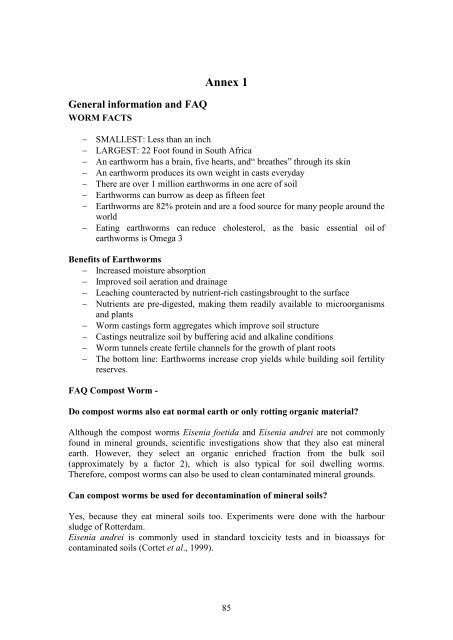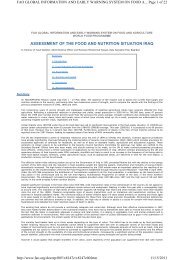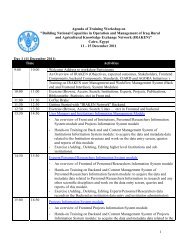Vermiculture in Egypt: - FAO - Regional Office for the Near East and
Vermiculture in Egypt: - FAO - Regional Office for the Near East and
Vermiculture in Egypt: - FAO - Regional Office for the Near East and
Create successful ePaper yourself
Turn your PDF publications into a flip-book with our unique Google optimized e-Paper software.
General <strong>in</strong><strong>for</strong>mation <strong>and</strong> FAQ<br />
WORM FACTS<br />
Annex 1<br />
SMALLEST: Less than an <strong>in</strong>ch<br />
LARGEST: 22 Foot found <strong>in</strong> South Africa<br />
An earthworm has a bra<strong>in</strong>, five hearts, <strong>and</strong> “ brea<strong>the</strong>s” through its sk<strong>in</strong><br />
An earthworm produces its own weight <strong>in</strong> casts everyday<br />
There are over 1 million earthworms <strong>in</strong> one acre of soil<br />
Earthworms can burrow as deep as fifteen feet<br />
Earthworms are 82% prote<strong>in</strong> <strong>and</strong> are a food source <strong>for</strong> many people around <strong>the</strong><br />
world<br />
Eat<strong>in</strong>g earthworms can reduce cholesterol, as <strong>the</strong> basic essential oil of<br />
earthworms is Omega 3<br />
Benefits of Earthworms<br />
Increased moisture absorption<br />
Improved soil aeration <strong>and</strong> dra<strong>in</strong>age<br />
Leach<strong>in</strong>g counteracted by nutrient-rich cast<strong>in</strong>gsbrought to <strong>the</strong> surface<br />
Nutrients are pre-digested, mak<strong>in</strong>g <strong>the</strong>m readily available to microorganisms<br />
<strong>and</strong> plants<br />
Worm cast<strong>in</strong>gs <strong>for</strong>m aggregates which improve soil structure<br />
Cast<strong>in</strong>gs neutralize soil by buffer<strong>in</strong>g acid <strong>and</strong> alkal<strong>in</strong>e conditions<br />
Worm tunnels create fertile channels <strong>for</strong> <strong>the</strong> growth of plant roots<br />
The bottom l<strong>in</strong>e: Earthworms <strong>in</strong>crease crop yields while build<strong>in</strong>g soil fertility<br />
reserves.<br />
FAQ Compost Worm -<br />
Do compost worms also eat normal earth or only rott<strong>in</strong>g organic material?<br />
Although <strong>the</strong> compost worms Eisenia foetida <strong>and</strong> Eisenia <strong>and</strong>rei are not commonly<br />
found <strong>in</strong> m<strong>in</strong>eral grounds, scientific <strong>in</strong>vestigations show that <strong>the</strong>y also eat m<strong>in</strong>eral<br />
earth. However, <strong>the</strong>y select an organic enriched fraction from <strong>the</strong> bulk soil<br />
(approximately by a factor 2), which is also typical <strong>for</strong> soil dwell<strong>in</strong>g worms.<br />
There<strong>for</strong>e, compost worms can also be used to clean contam<strong>in</strong>ated m<strong>in</strong>eral grounds.<br />
Can compost worms be used <strong>for</strong> decontam<strong>in</strong>ation of m<strong>in</strong>eral soils?<br />
Yes, because <strong>the</strong>y eat m<strong>in</strong>eral soils too. Experiments were done with <strong>the</strong> harbour<br />
sludge of Rotterdam.<br />
Eisenia <strong>and</strong>rei is commonly used <strong>in</strong> st<strong>and</strong>ard toxcicity tests <strong>and</strong> <strong>in</strong> bioassays <strong>for</strong><br />
contam<strong>in</strong>ated soils (Cortet et al., 1999).<br />
85





